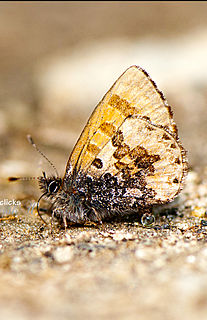Related Research Articles

Orthomiella pontis, the straightwing blue, is a small butterfly found in India that belongs to the lycaenids or blues family.

Neptis nata, the clear sailer or dirty sailer, is a species of nymphalid butterfly found in south and southeast Asia.

Iraota timoleon, the silverstreak blue, is a species of lycaenid or blue butterfly found in Asia.
Ethmia spyrathodes is a moth in the family Depressariidae first described by Edward Meyrick in 1922. It is found in São Tomé and Príncipe, off the western coast of Central Africa.
Choreutis porphyratma is a moth in the family Choreutidae. It was described by Edward Meyrick in 1930. It is found on New Guinea.
Metasia strangalota is a moth in the family Crambidae. It was described by Edward Meyrick in 1887. It is found in Australia, where it has been recorded from New South Wales.
Atasthalistis pyrocosma is a moth in the family Gelechiidae. It was described by Edward Meyrick in 1886. It is found on New Guinea and Australia, where it has been recorded from Queensland.
Kertomesis acatharta is a moth in the family Autostichidae. It was described by Edward Meyrick in 1911. It is found in India.
Stenoma nebrita is a moth of the family Depressariidae. It is found in Panama, Costa Rica and Guyana.
Doxogenes brochias is a moth in the family Lecithoceridae. It was described by Edward Meyrick in 1905. It is found in Sri Lanka.
Crocanthes pyrochorda is a moth in the family Lecithoceridae. It was described by Edward Meyrick in 1910. It is found on New Guinea.
Crocanthes thermocharis is a moth in the family Lecithoceridae. It was described by Edward Meyrick in 1931. It is found on New Guinea.
Crocanthes heliograpta is a moth in the family Lecithoceridae. It was described by Edward Meyrick in 1929. It is found on New Guinea.
Comocritis thespias is a moth in the family Xyloryctidae. It was described by Edward Meyrick in 1909. It is found in Sri Lanka.
Aeolanthes ampelurga is a moth in the family Depressariidae. It was described by Edward Meyrick in 1925. It is found in northern India (Kumaon).
Eutorna caryochroa is a species of moth in the family Depressariidae. It was described by Edward Meyrick in 1889. It is endemic to New Zealand.
Filinota cassiteranthes is a moth in the family Depressariidae. It was described by Edward Meyrick in 1932. It is found in Bolivia.
Anchinia porphyritica is a moth in the family Depressariidae. It was described by Edward Meyrick in 1914. It is found in Assam, India.
Imma cuneata is a moth in the family Immidae. It was described by Edward Meyrick in 1906. It is found in Brazil and Colombia.
Imma autodoxa is a moth in the family Immidae. It was described by Edward Meyrick in 1886. It is found on Fiji.
References
- ↑ Savela, Markku, ed. (September 2, 2018). "Gonaepa heliarcha (Meyrick, 1886)". Lepidoptera and Some Other Life Forms. Retrieved August 30, 2020.
- ↑ Transactions of the Entomological Society of London. 1886 (3): 278.
| This article on a moth of the subfamily Gelechiinae is a stub. You can help Wikipedia by expanding it. |